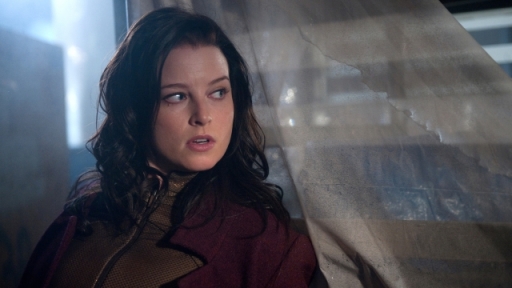Look, I know I said that I admire the creators of Continuum for their commitment to putting a gunfight into every episode, but this week’s shootout was kind of dull. Maybe it was because Kierra’s partner Carlos was the one taking aim at Liber8 member Curtis, and boy, Carlos is just eight different flavors of vanilla. More likely, it was just that the action itself wasn’t exciting. They’re both firing at each other behind cover, nothing really seems to be at stake, and the whole thing is just static… that is, until Curtis pops out from behind his cover, jumps off of a wall and punches Carlos in the face.
At that point, what was a dull gunfight turns into an exciting fistfight. Even more exciting was that Kierra got involved after a few minutes. I was worried that the show was having Carlos trade blows with Curtis because the creators were uncomfortable having a man and woman wail on each other, but I let go of that when Curtis threw Kierra through a window. Kierra is supposed to be a tough-as-nails future-cop action hero, and I’m glad the show lets her get down and dirty. I’ll even forgive the fact that the fight ends with a trick used to better (and gorier) effect in Dredd 3D. Up until then, it’s a good fight, surprisingly good for a television show. There’s a real dearth of good fight scenes on TV.
I’m willing to forgive Continuum for a lot of flaws because the show itself is something we don’t have a lot of: a serialized sci-fi action/drama. Yeah, I know, we all miss Firefly, but it ain’t coming back, and what do you expect me to watch, Revolution? Please. Besides, Continuum has one major advantage over both of those shows: time travel. I’m struggling to come up with another show that has used time travel as the basis of its plot the way Continuum does… the closest I can think of is Samurai Jack.
“Wasting Time” is the least time-travel-centric episode of Continuum yet. Sure, that trip into the past is still hanging on the edge of the plot, influencing the actions of almost every character, but this episode was more about the immediate needs of Liber8 and how that puts them into conflict with Kierra. Those needs have something to do with an mysterious illness contracted by the leader of Liber8, and the lengths that one member (Sonya, aka The Queen of Hearts”) will go through to save him. The flashback at the episode’s beginning gives the impression that “Wasting Time” will be all about Kierra’s attempt to stop Sonya’s killing spree, which includes removing the pituitary gland of her victims so she can use their genetic code to synthesize a super-steroid… or something. Turns out, not so much.
(Sidebar here: I have no idea what’s going on with Liber8. Their situation and their goals seem to change episode-to-episode. In the pilot, I got the impression that they were stranded in 2012, but that they intended to carry out their pre-revolution anyway. When the second episode opened, they were talking about a plan to get back to their original destination. In this episode, Travis is suddenly dying of an unexplained illness. I don’t know if SyFy is airing these episodes with scenes missing, but it sure felt like it this week. They’re certainly placing the commercial breaks at the wrong point, which is especially awkward when we come back from commercial just in time for the dramatic act break. But I digress.)
The whole pituitary-gland thing just fizzles out—or, rather, Liber8’s plans to synthesize a cure for their leader work out exactly as planned. But the possibility of Travis’s death drives a wedge between members Curtis and Kellog, which leads to the aforementioned shootout/fistfight and to Kellog’s banishment from the group. Kellog claims to be a non-violent member of Liber8 and wants to start a new life in 2012, so he strikes up a bargain with Kierra.
Kellog’s alliance with Kierra is a welcome development because it gives Kierra an ally that isn’t Alec—though Alec is awesome—or Carlos (aka GuyCop McBlanderson) and because it provides some much-needed character development for the supporting cast. So far, the members of Liber8 have been characterized just enough to serve as cannon fodder. Don’t get me wrong, I think Curtis’s actions in this episode made sense for his character, it would just be nice if his character was more than “kill innocents and also everyone else”. But, he’s dead now, so maybe that would have just been wasted time. Oh, hey, that’s the name of the episode. How fun!
No show is without flaws, but Continuum is surprisingly well made for a Canadian import doing a second-run on SyFy. I realize that a show’s genre or its channel/country of origin is no excuse for sloppy storytelling, but the fact that this show is so unique makes me more forgiving when episodes come out lumpy and weird. I only hope the creators can tighten things up so that this show can live up to the highest standard it can hope to achieve: solid B-level television. You know what? Make that B+. Reach for the stars, Continuum, reach for the stars.
- Kierra’s longing stare at the happy family in the restaurant was a nice way to remind us of how much she misses her home without beating us over the head with it.
- Dredd 3D is pretty okay, if you were wondering. It’s better than you would expect but the story is still kind of dull. I wish I’d seen it in 3D.
- “You’re a terrorist and a revolutionary.”“No, that guy won’t be born until 2041.” Dang, that’s cool. Time travel is cool.






